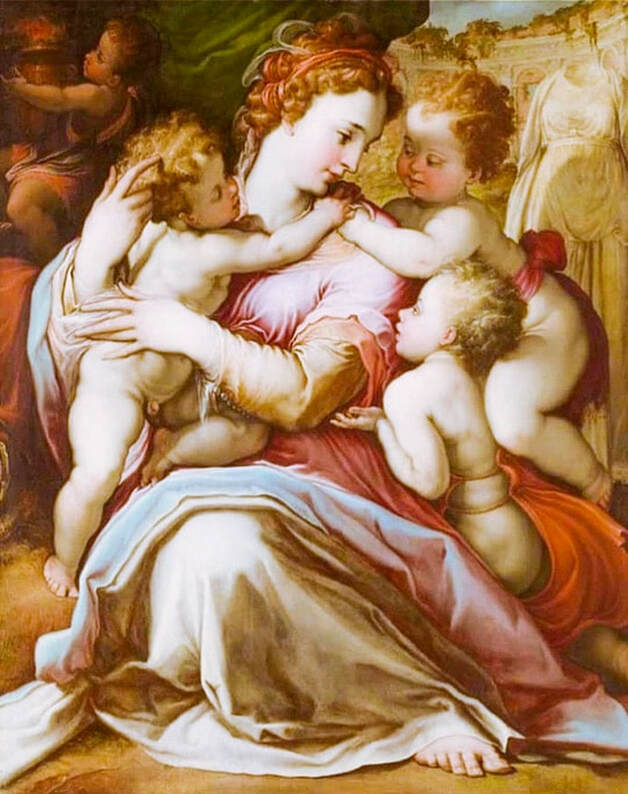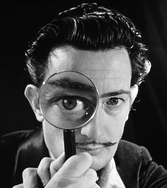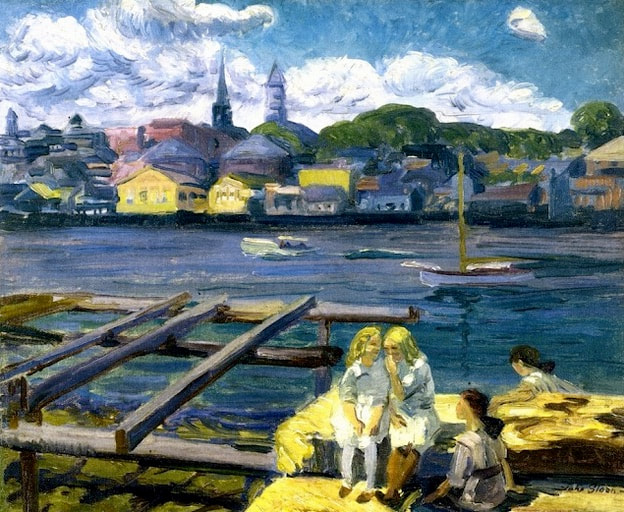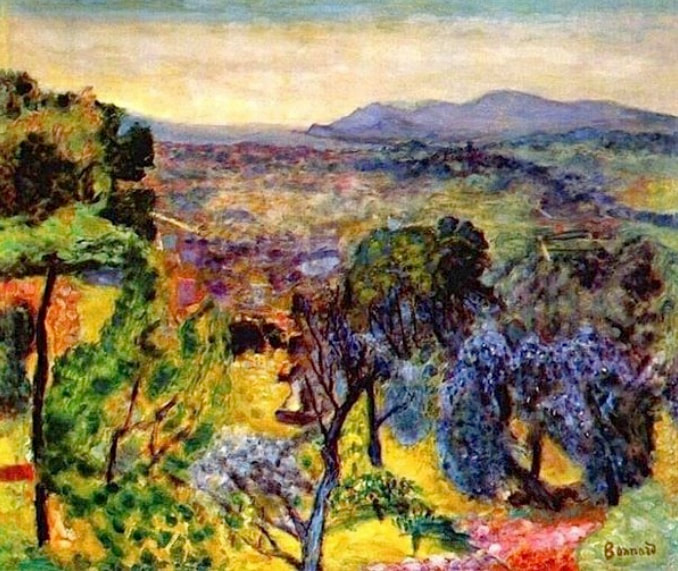|
Francesco de' Rossi, (Salviati), "Charity" (Caritas), c.1543-45; Alte Pinakothek, Munich. Francesco de' Rossi, also known as Il Salviati or Salviati, created two paintings called "Charity" (Caritas) around the same time. The one shown above is at the Alte Pinakothek in Munich. The other is at the Uffizi Gallery in Florence. Many people aren't aware that these are two separate paintings, and images of the Munich work are sometimes attributed to the Uffizi collection. Even Wiki listings have made this mistake, and several art vendors have failed to note the difference in connection with their reproductions. The image below, seen recently, was mislabled as the Uffizi work and also has been digitally altered: excessive editing has obscured a lot of the coloring, detail, depth and subtlety of the original. Altered version of a painting by Salviati. Francesco de' Rossi (Salviati), Charity, c.1545; Uffizi Gallery, Florence THE ART DETECTIVE Bloopers, Fakes & Mistakes
0 Comments
Claude Monet, Water Lilies and Agapanthus (Nymphéas et agapanthes), c.1914-17; Musée Marmottan Monet. The magnificent, watery blues and greens of this beautiful Monet painting have turned purple in the modern reproduction shown below. The original hues can be seen clearly in the first photo above, which comes from a 2012 Monet exhibition at the Sakip Sabanci Müesi, Istanbul. The second image is a page from a book about the Musée Marmottan Monet, Paris, where the painting is located. Although the contemporary version has made an attempt to mimic the brushwork and overall appearance of the original, the changes in color seem completely random, and reduce the natural, watery effect that is so typical of Monet's water lily paintings. Altered version of a painting by Claude Monet. Copywriting & Consultations
John French Sloan, Tittering Girls, 1914; private collection. The color changes in the reproduction shown below of John Sloan's Tittering Girls are fairly extreme, and include several randomly yellow objects in the foreground and distance. Not only that, but the composition is reversed. Possibly the contemporary artist was looking in a mirror or was working from a photo that had already been flipped. In any case, the new version differs significantly from the original, where the coloring, brushwork, contrast and naturalistic details reflect the artist's usual style. There are very few examples of the painting available, probably because it's rarely seen in public. The photo above is from a 1999 exhibition at the Georgia Museum of Art. Unfortunately, the lack of authentic images has led many art fans to adopt the vastly different reproduction as the standard for this artwork. Altered, reversed reproduction of a painting by John Sloan. THE ART DETECTIVE Bloopers, Fakes & Mistakes
Heinrich Eddelien, The Origin of Painting, 1831; Statens Museum for Kunst, Copenhagen. The highly detailed, realistic style of many older paintings, such as this work by Danish artist Heinrich Eddelein, is very difficult to duplicate, especially in a demanding commercial environment where fast turnaround is essential. Reproductions tend to be easier to spot — they often appear sketchy, with false colors, lack of depth and contrast, and an overall sense of speed. The reproduction below is also overly yellow and hasn't made much of an attempt to make the greenery look real. Altered reproduction of a painting by Heinrich Eddelien. Joan Miró, "Constellation: Awakening in the Early Morning," 1941; © Successió Miró / Artists Rights Society (ARS), New York / ADAGP, Paris; Kimbell Art Museum. Awakening in the Early Morning (Awakening at Dawn) is one of the 23 works in Miró's Constellation series. The reproduction below clearly has made extensive changes, and the photo itself seems to have amplified the granularity of the surface texture. According to the Kimbell Art Museum, Miró wrote that the series was "one of the most important things I have done, and even though the formats are small, they give the impression of large frescoes." The museum goes on to add: By July 1940 Miró and his family had fled Nazi-occupied France. [...] The Constellation series was smuggled to New York, where part of it was exhibited at the Pierre Matisse Gallery in January, 1945. Symbolic of the survival of great art in the face of the ongoing war, these small works had important implications for American painters such as Jackson Pollock as they created abstract compositions permeated with free-floating lines and forms. Altered version of a painting by Joan Miro. Corrections or suggestions?
Giovanni Giacometti, "Ottilia, A Portrait," 1913; private collection. Photo: Kunsthaus Zürich. Normally hidden away in a private collection, this Giovanni Giacometti painting of his daughter Ottilia received public attention and press coverage during a 2019 exhibition at the Kunsthaus Zürich. Very little detail remains in the modern reproduction shown below, and there are color changes throughout. Note the mark of the art vendor lower left. Most contemporary copies aren't exact — and are often much different from the original — so a watermark with an Internet address is a good indicator that you'll need to look elsewhere for a more accurate photo. Highly altered version of a painting by Giovanni Giacometti. Pierre Bonnard, Cannet Landscape, c.1925, private collection. Photo: © Sotheby's. Lots of color changes in the modern reproduction below, with added contrast that blurs many of the details. Although European landscapes of this period tend toward abstraction, they often retain a link with the natural world through the use of elements such as green trees and plants, blue sky, earth tones and so on. The reproduction seems to have ignored the painting's naturalistic qualities, altering the palette and also damaging the depth, energy flow, and emotion of the original. The image above is from Sotheby's, where the authentic work sold in 2014 for $2,045,000. Altered version of a painting by Pierre Bonnard. Gustav Klimt, Dancer, c.1916-18; private collection. Photo: ©Neue Galerie, New York. Klimt reproductions are often very different from the originals, probably because there's so much fine detail and subtlety in the colors and patterns — very difficult to duplicate. In the reproduction below, the face has been altered, many tiny details have been changed or ignored, and — in an unusual twist — extra sections have been added on both sides to widen the picture. There seem to be smaller additions at the top and bottom as well. The photo of the work on display is from a 2016 exhibition called Klimt and the Women of Vienna's Golden Age at the Neue Galerie, New York. Altered version of a painting by Gustav Klimt. Corrections or suggestions?
Claude Monet, Bouquet of Sunflowers, 1881; The Metropolitan Museum of Art, New York. There are many different versions of Monet's Sunflowers in circulation, but the reproduction below is one of the most extreme. Excessive contrast obscures most of the detail — the leaves have become blobs of black in places — and there are seemingly random color changes throughout. This is a case where an accurate photo is easily available: a quick search on the general phrase "Sunflowers Monet" yields the Met's listing at or near the top. The museum adds the following note: Van Gogh wrote, "Gauguin was telling me the other day that he's seen a painting by Claude Monet of sunflowers in a large Japanese vase, very fine. But — he likes mine better. I'm not of that opinion." Altered version of a painting by Claude Monet. THE ART DETECTIVE Bloopers, Fakes & Mistakes
William Merritt Chase, Hall at Shinnecock, 1892; Terra Foundation for American Art. The purple and orange coloring in the altered version below should be a tip-off that it's probably a modern interpretation rather than a true copy of the original. In a naturalistic scene like this, those dresses would be white, and the wood in the ceiling and floor probably wouldn't be so orange. It's almost as though two filters have been added to the original photo, for no particular reason. This is probably a recently painted reproduction of William Merritt Chase's famous painting, although, assuming a lot of tampering, it could be the result of a digital edit. Altered version of a painting by William Merritt Chase. |
REAL or REPRO?
A well-researched art resource that can help you find accurate images and spot altered copies. 100+ listings and growing daily. Browse at random, or search for something specific. Special requests are welcome.
Categories
All
Archives
January 2021
Disclaimer: This blog is intended for entertainment purposes only. Although every effort has been made to verify the accuracy of the information provided, the material included here should in no way be considered the final authority on any issues discussed in the text.
|































 RSS Feed
RSS Feed